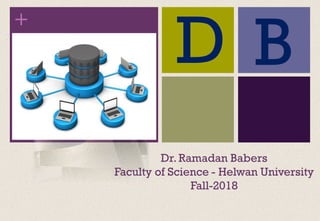Db lec 01
- 1. + Dr. Ramadan Babers Faculty of Science - Helwan University Fall-2018 D B
- 10. + Database Systems Basic Concepts 10
- 11. Unit01 Outlines Types of Databases and Database Applications Basic Definitions Typical DBMS Functionality Examples of a Database Main Characteristics of the Database Approach Database Users Advantages of Using the Database Approach 11
- 12. Introduction 12
- 13. Introduction 13
- 14. Examples of Database Applications • Purchases from the supermarket • Purchases using your credit card • Booking a holiday at the travel agents • Using the local library • Taking out insurance • Studying at university 14
- 15. File-Based Systems Collection of application programs that perform services for the end users (e.g. reports). Each program defines and manages its own data. 15
- 18. Definitions 18 Data: known facts that can be recorded Database: a collection of data represents some aspect of the real world logically coherent collection (not a random collection) designed, built & populated for a specific purpose Database Management System: the software that manages the data
- 19. Database Management System (DBMS) 19
- 20. Advantages of DBMSs 20 Control of data redundancy Data consistency More information from the same amount of data Sharing of data Improved data integrity Improved security Enforcement of standards
- 21. Advantages of DBMSs 21 Improved data accessibility and responsiveness Increased productivity Improved maintenance through data independence Increased concurrency Improved backup and recovery services
- 22. Disadvantages of DBMSs 22 Complexity Size Cost of DBMS Additional hardware costs Cost of conversion Higher impact of a failure
- 23. Database Activity Conceptual Data Modeling 23 Project Identification and Selection Project Initiation and Planning Analysis Physical Design Implementation Maintenance Logical Design
- 25. Architecture 25 DBMS can be seen as either single tier or multi-tier. Database (Data) Tier: At this tier, the database resides along with its query processing languages. Relations, data and their constraints exist at this level. Application (Middle) Tier: sits in the middle and acts as a mediator between the end-user and the database. User (Presentation) Tier: multiple views of the database can be provided by the application.All views are generated by applications that reside in the application tier.
- 26. Data Models 26 Data models Define how the logical structure of a database is modeled. Are fundamental entities to introduce abstraction in a DBMS. Define how data is connected to each other (Relationships) and how they are processed and stored inside the system. The first data model could be flat data-models, where all the data used are to be kept in the same plane and contain lots of duplication and update anomalies.
- 27. Entity-Relationship Model (ER Model) 27 ER Model contains: 1) Entity set, 2) Relationship set, 3) General attributes, and 4) Constraints. Entity Attributes
- 28. Entity-Relationship Model (ER Model) 28 1) Entity An entity can be a real-world object. For example, in a school database, students, teachers, classes, and courses offered can be considered as entities. All these entities have some attributes or properties that give them their identity. An entity set is a collection of similar types of entities.
- 29. Entity-Relationship Model (ER Model) 29 2) Attribute Entities are represented by means of their properties called attributes. All attributes have values. For example, a student entity may have name, class, and age as attributes.
- 30. Entity-Relationship Model (ER Model) 30 There exists a domain or range of values that can be assigned to attributes. For example, a student's name cannot be a numeric value. It has to be alphabetic. A student's age cannot be negative, etc.
- 31. Entity-Relationship Model (ER Model) 31 Types of Attributes Simple attributes: are atomic values. For example, a student's phone number is an atomic value of 10 digits. Composite attribute: are made of more than one simple attribute. For example, a student's complete name may have first_name and last_name.
- 32. Entity-Relationship Model (ER Model) 32 Types of Attributes Multivalued: attributes are depicted by double ellipse. Derived attribute: are the attributes that do not exist in the physical database, but their values are derived from other attributes present in the database. For example, average_salary and age.
- 33. Entity-Relationship Model (ER Model) 33 Entity-Set and Keys Key is an attribute or collection of attributes that uniquely identifies an entity among entity set. For example, the ID_number of a student makes him/her identifiable among students. Keys Types Super Key: A set of attributes (one or more) that collectively identifies an entity in an entity set. Candidate Key: A minimal super key is called a candidate key. An entity set may have more than one candidate key. Primary Key: A primary key is one of the candidate keys chosen by the database designer to uniquely identify the entity set.
- 34. Entity-Relationship Model (ER Model) 34 3) Relationship The relationship is the association among entities. For example, an employee works_at a department, a student enrolls in a course. Here, Works_at and Enrolls are called relationships. Employee Departmrnt Student Course Works at enrolls
- 35. Entity-Relationship Model (ER Model) 35 Degree of Relationship The number of participating entities in a relationship defines the degree of the relationship.
- 36. Entity-Relationship Model (ER Model) 36 Degree of Relationship One-to-one: One entity from entity set A can be associated with at most one entity of entity set B and vice versa.
- 37. Entity-Relationship Model (ER Model) 37 Degree of Relationship One-to-many: One entity from entity set A can be associated with more than one entities of entity set B, however an entity from entity set B can be associated with at most one entity.
- 38. Entity-Relationship Model (ER Model) 38 Degree of Relationship Many-to-many: One entity from A can be associated with more than one entity from B and vice versa.





































